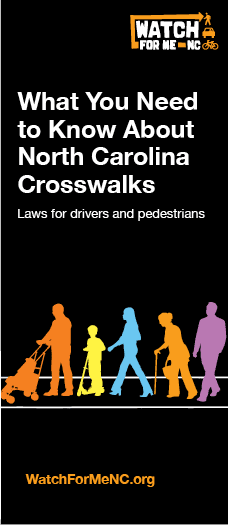Share this Post
If you’ve been pulled over recently and gently reminded that it is a law to yield to pedestrians in a crosswalk, you are not alone.
All summer, the Institute for Transportation Research and Education (ITRE) at NC State in conjunction with the Raleigh Police Department, Watch for Me NC, and the Governor’s Highway Safety Program has been running a research project on ‘Crosswalk Yielding Enforcement.’
At five specifically chosen crosswalks throughout Raleigh, an operation is in place to record and enforce vehicular behavior in response to pedestrians. An off-duty officer in plainclothes steps off the curb when a vehicle reaches a pre-determined point and then he gauges the reaction of that vehicle. If the vehicle stops for that pedestrian, that officer in the crosswalk, then no further action is taken. If the vehicle doesn’t stop and the pedestrian (officer) has to yield, then the officer calls the vehicle’s information in to a police unit up the road and a traffic stop is made.
 Some very astute drivers have noticed this operation and are describing it as a ‘sting,’ a deceptive police operation designed to catch a person committing a crime.
Some very astute drivers have noticed this operation and are describing it as a ‘sting,’ a deceptive police operation designed to catch a person committing a crime.
Jim Sughrue, Director of Public Affairs for the Raleigh Police Department, dismisses that notion for several reasons—most of all, because this was initiated and controlled by the researchers at ITRE. “It’s a research project. We are simply gathering information that will help improve pedestrian safety and measure the effectiveness of enforcement,” Sughrue says.
Kristy Jackson, Research Associate with ITRE confirms this: “We are attempting to determine the level of enforcement necessary to change drivers’ behavior at crosswalks.”
Initiated and funded by the Governor’s Highway Safety Program, this research and educational initiative hopes to understand how much enforcement would be needed to change drivers’ behavior at crosswalks.
To determine this, four of the five sites are established as described, with a plainclothes officer acting as the pedestrian armed with a radio to dispatch a traffic stop as needed. One site does not have an officer present; it is the ‘control’ in the experiment.
At the control site, the researcher steps into the crosswalk when a vehicle is at a predetermined distance away, just as the officer does, however there is no follow-up here, no enforcement of the law, no educational reminders or pamphlets. The researcher simply records data of how many vehicles yield and how many do not.
After the active enforcement phase ends, ITRE researchers will return to those five sites and measure data as pedestrians similar to the current control site. If enforcement and education are effective, they would expect to see an improved rate of yielding at the four sites that had officers and not much change at the ‘control’ site. Active enforcement and apprehension units will continue through August with the study concluding in September.
In this phase of the study, the officers who are enforcing by making the traffic stop are generally providing information or distributing educational leaflets (as pictured).
Sughrue explains further: “Except in egregious circumstances, the traffic stop involves nothing more than education and information about what the law is and the fact that drivers are required to stop. If somebody speeds up, honks the horn or the officer has to jump out of the way, then, on those rare occasions, I know we’ve issued some citations, but not many.”
This study is being done as both pedestrian and vehicular traffic is growing in Raleigh and more people are moving to ‘live-work-play’ walkable communities like Downtown, Cameron Village and North Hills.
In fact, when plans for the expanded North Hills were first drawn, sketches depicted a proposed pedestrian bridge over Six Forks. However, that has yet to come to fruition. Will studies such as these create a basis for funding pedestrian bridges? Jackson is slow to speculate: “I provide the data, and I let other people decide what they’re going to do with it.
Share this Post





Comments
Pingback: ITRE in the News: Crosswalk Crackdown : Institute for Transportation Research and Education